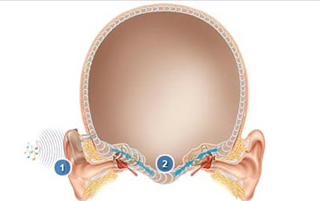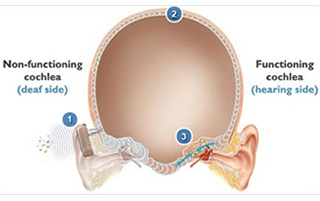 | |
| The Baha System | The Sound Processor |
What IS A BAHA?
The Bone Anchored Hearing Aid (BAHA) is a surgically implanted device designed to help people with hearing loss. The majority of the conventional hearing aids transmit sound through the medium of air conduction. BAHA stimulates the cochlea by transmitting the sound waves through the bones in our skull, or bone conduction, thereby bypassing the outer and middle ear. Once the cochlea receives the sound signals, the information is converted in to neural signals and transferred to the brain, where it is perceived as sound. thereby bypassing the outer and middle ear.
Who Can Benefit From a BAHA?
 A second category of candidates are patients with “single sided deafness”. This includes patients who have lost all or most hearing in one ear, in which a conventional hearing aid is not helpful, but have good hearing in the other. A BAHA may provide an excellent hearing alternative for patients who cannot benefit from a traditional hearing aid, or in other words, for an ear that is “un-aidable” with a conventional hearing aid. BAHA is FDA approved for children over the age of 5. For children under the age of 5, a BAHA is available with an adjustable soft head band.
A second category of candidates are patients with “single sided deafness”. This includes patients who have lost all or most hearing in one ear, in which a conventional hearing aid is not helpful, but have good hearing in the other. A BAHA may provide an excellent hearing alternative for patients who cannot benefit from a traditional hearing aid, or in other words, for an ear that is “un-aidable” with a conventional hearing aid. BAHA is FDA approved for children over the age of 5. For children under the age of 5, a BAHA is available with an adjustable soft head band.The Baha system, which is based on bone conduction, utilizes a titanium implant, which is placed in the skull bone behind the non-functioning ear. An abutment connects the sound processor with the implant in the bone. This creates direct (percutaneous) bone conduction. In contrast, traditional bone conductors connect indirectly to the bone through unbroken skin (transcutaneous) and work by exerting pressure against the skull.irect bone conduction, provided by Baha, may give improved access to sound when compared to traditional bone conductors because sound is not weakened when passing through the skin, muscle and fat covering the skull.
 Images Courtesy of Cochlear | Sound Processor snaps onto abutment. Abutment is attached to the titanium implant placed in the bone. |
 Images Courtesy of Cochlear | Direct Bone Conduction1. Sound waves are received by Baha sound processor2. Sound waves bypass middle ear function and are delivered directly to the working cochlea in both ears |
 Images Courtesy of Cochlear | Baha for Single Sided DeafnessFor people with Single Sided Deafness (SSD), the Baha system allows sound to be heard from the deaf side, provided that hearing is normal in the opposite ear. This is possible because the sound waves are transmitted through the skull bone to the functioning cochlea on the opposite side.1. Sound waves are received by the Baha sound processor 2. Sound waves travel by bone conduction to the functioning cochlea on the opposite side 3. Sound is received by functioning cochlea |
After a period of two months (six months for children) the implant will have osseo integrated with the bone. The sound processor may now be attached to the abutment, enabling the recipient to hear with the Baha® system fully in place for the first time.
The audiologist will explain the various functions of the sound processor, and will demonstrate the technique necessary for removal and fitting of the processor.
Connecting and disconnecting the sound processor is very simple. A plastic snap is mounted to the sound processor. It is designed to snap into the abutment and hold the sound processor securely in place.
BAHA Surgery
The implantation of the BAHA is a simple procedure done in the operating room which takes approximately 1 hour. The patient has the choice of general or local anesthesia. A special skin graft is performed behind the deaf ear, and the skin follicles and fat are removed from the scalp. A hole is drilled into the skull and the titanium screw and abutment are inserted together. The skin is brought over the abutment, and a small hole is made in the skin through which the abutment protrudes. The skin is sewn back into position and 2 dressings are applied. The outer dressing is removed the next day and the inner dressing is worn for 7-10 days. There is little post-operative pain and patients are able to return to most functions of their lives the next day. The skin is usually healed within 2 weeks, but the hearing is not worn for 2 months, giving time for the bone to osseo integrate into the titanium screw. | ||
| Abutment without the processor in place | Divino processor in place | Hair covering processor |
| BAHA Divino processor worn by a patient who has undergone a previous acoustic neuroma surgery. | ||
 |
| Short hair provides good cosmetic effect |
Advantages of BAHA
- Direct Bone Conduction allows the recipient to hear sounds more clearly and naturally.
- Potential recipients can easily test the Baha so that they can experience the benefits before they have surgery.
- The Baha is comfortable to wear; recipients say that they forget that they have it on.
- The Baha is in use by thousands of individuals around the world. The outcomes are predictable and well documented.
- The Baha procedure is reversible and does not damage or harm residual hearing. Additionally, the Baha system does not preclude any benefits from future hearing technological advances because it doesn’t compromise middle or inner ear or compromise hearing nerve sensitivity.
- Many insurance companies pay for the surgical procedure and some pay for the processor.
Baha Sound Processors
BP 100, Intenso and Cordelle are three BAHA sound processors available in the market today. The new Cochlear BP 100 is the first programmable bone conduction device. The BAHA sound processors are compatible with external equipment such as IPods, MP3 players and cell phones to name a few. The external processor is available with a built-in directional microphone and an adjustable volume control.Please talk to our medical or audiology team to discuss if you are a BAHA candidate. The test device can be borrowed and tried to see if you are a suitable candidate.
Baha® 4 Attract System

How the Baha 4 Attract System works: A small implant made of titanium is inserted in the bone behind the ear. The implant magnet is attached and hidden beneath the skin. A sound processor is then attached to an external magnet and sound is transmitted as vibrations from the processor via the magnets to the implant, which then directs them through the bone to stimulate the inner ear.
For extra comfort, the Baha SoftWear™ Pad attaches to the external magnet, adapts comfortably to the shape of the head, and distributes pressure evenly.

An invisible connection to better hearing
The new BAHA 4 Attract system
offers invisible connection to hearing and better hearing performance The new BAHA processor offers Smarter hearing and wireless freedom The Baha Sound Processor magnets are available in different strengths to suit individual patients and lifestyles.
http://www.earassociates.com/services-bone-anchored-hearing-aids-san-jose-ca.html
No comments:
Post a Comment